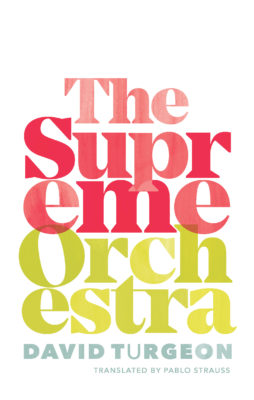Some novels hold their secrets tightly, leaving the reader to fumble in the darkness for any sense of where the book is leading them, while others let flow a glut of detail that can overwhelm and at times obscure what’s happening beneath the surface. Montreal writer David Turgeon manages to do both simultaneously in The Supreme Orchestra. The result is an entertaining and oftentimes convoluted novel that seems to be going everywhere, and nowhere, at once.
To begin to describe the plot intricacies of The Supreme Orchestra would pull a thread that stretches well beyond my word limit. It’s both an intriguing vivisection of the art scene in Bruant – a city in a fictional European country – and an espionage thriller replete with kidnappings, secret codes embedded in the lyrics of pop songs, and mysterious car rides in the back of dark sedans. These shady machinations, we eventually glean, are integral to the fate of a fictional African nation and its capital, Port Merveille. Both are worlds of money, power, ego, and deception.

The Supreme Orchestra
David Turgeon
Translated by Pablo Strauss
Coach House Books
$19.95
paper
220pp
9781552453759
It would be an understatement to call Turgeon’s style maximal. I often found myself searching for the greater significance in an overflow of digression and detail, and he pushes this to a perverse degree. With serpentine sentences loaded with quotidian observation, a penchant for the rich possibilities of language, and a constant regard for the absurd, he displays impressive insights into the motivations and manipulations of human behaviour. (Pablo Strauss has done a commendable job on the English translation in this regard). It’s also writing that shows its seams. In fact, at one point, Turgeon seems to self-reflexively write himself into the narrative, describing a film Simone and Charles watch as “about a simple young man condemned to invent stories in order, he claimed, to invent himself. These stories hung by the most tenuous of threads, forever threatening to snap, and they advanced to their conclusion via the most circuitous of paths, leaving us with at best a jury-rigged ending.”
This is an apt description of the book itself. For a novel with so much overwrought complexity, the ending indeed falls together with laughable simplicity and idealism. Throughout The Supreme Orchestra, Turgeon makes it apparent that clarity and plausibility are secondary to the novel’s role as an act of creation. At one point, in a moment of aesthetic reflection, the narrator opines: “Art is work for work’s sake.” David Turgeon seems to have taken that maxim to heart in creating The Supreme Orchestra. mRb






0 Comments